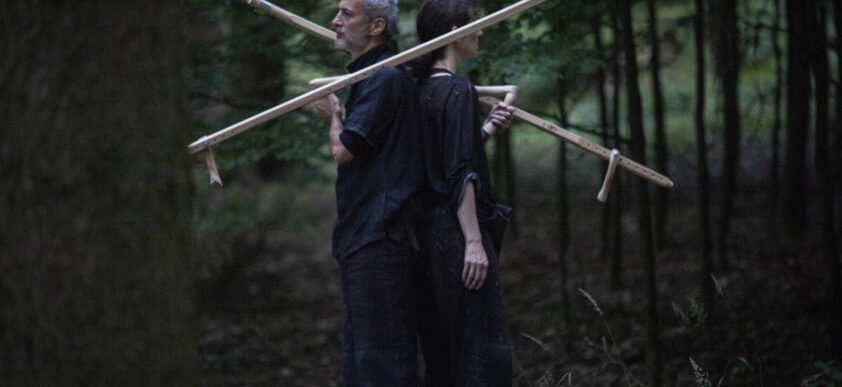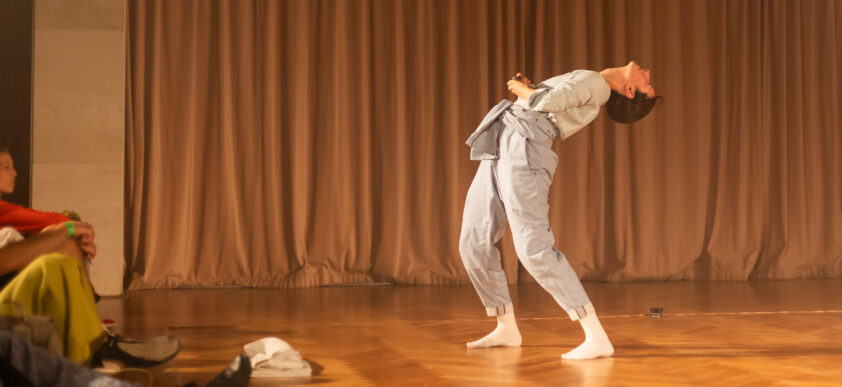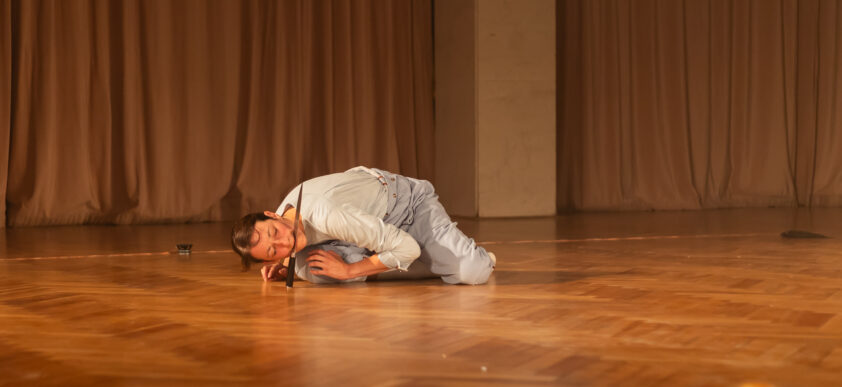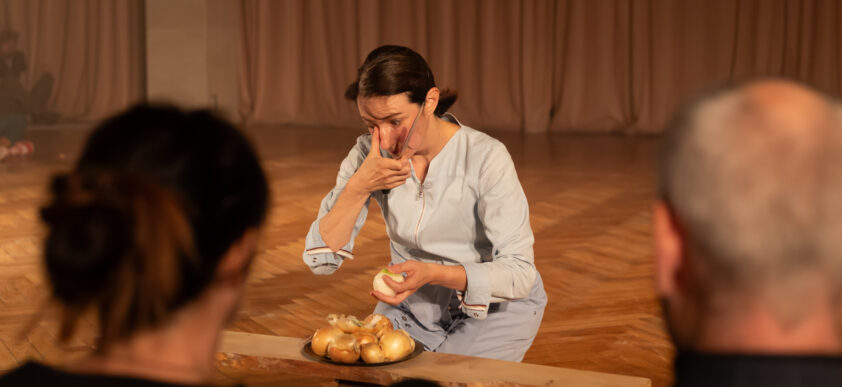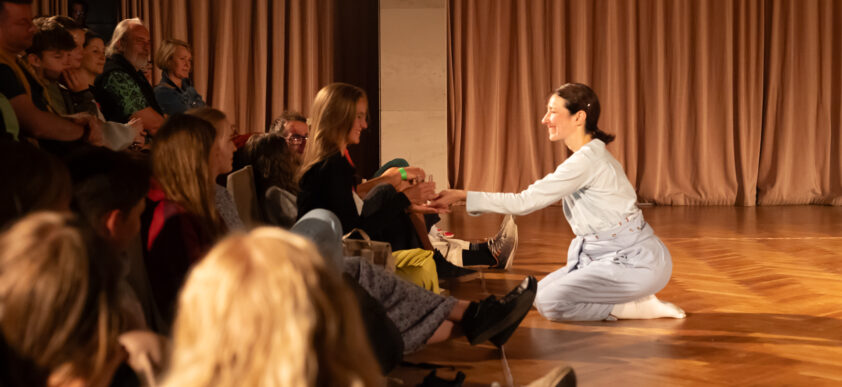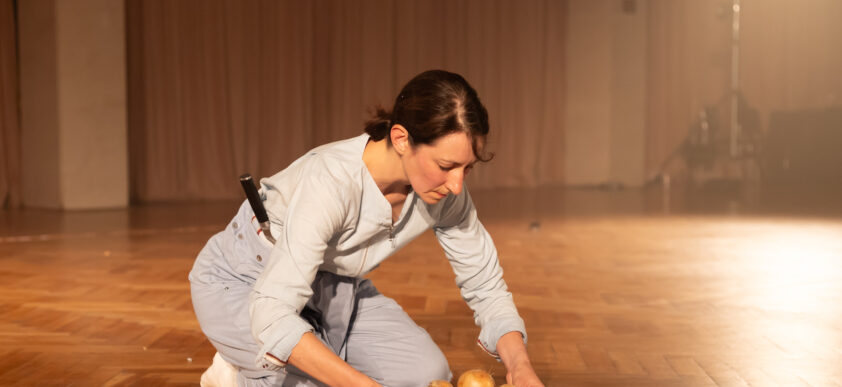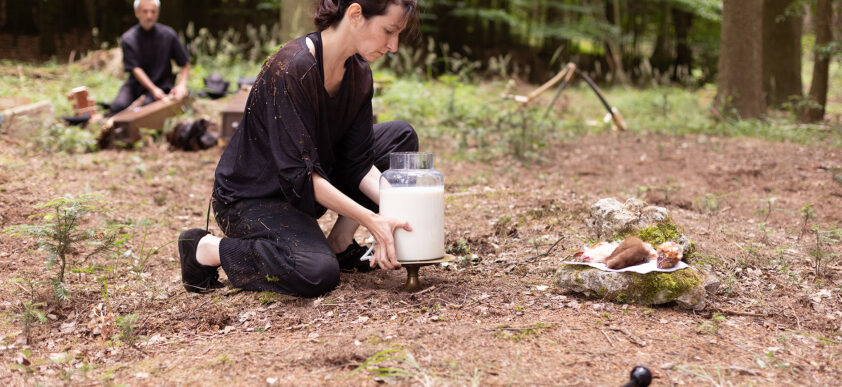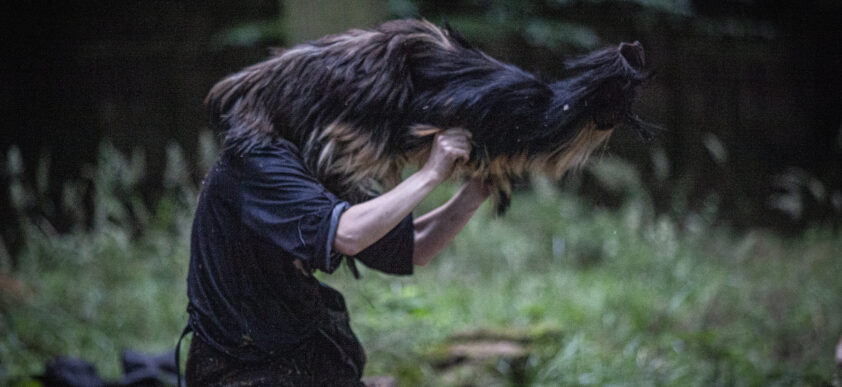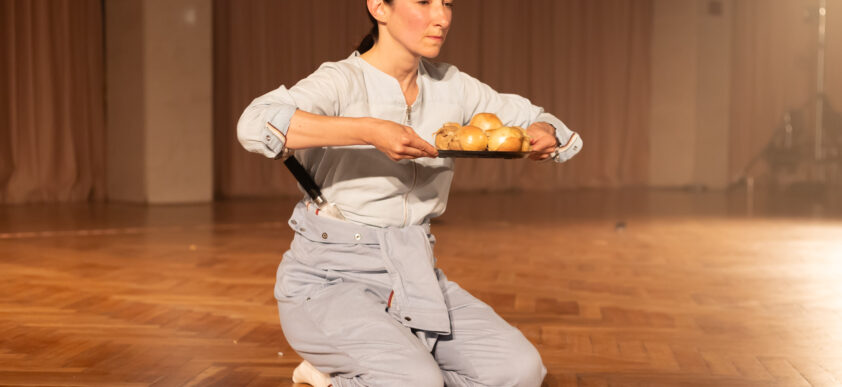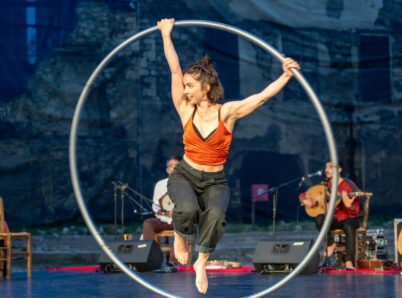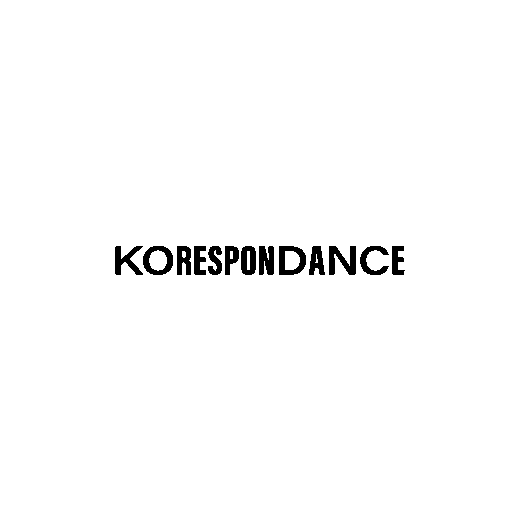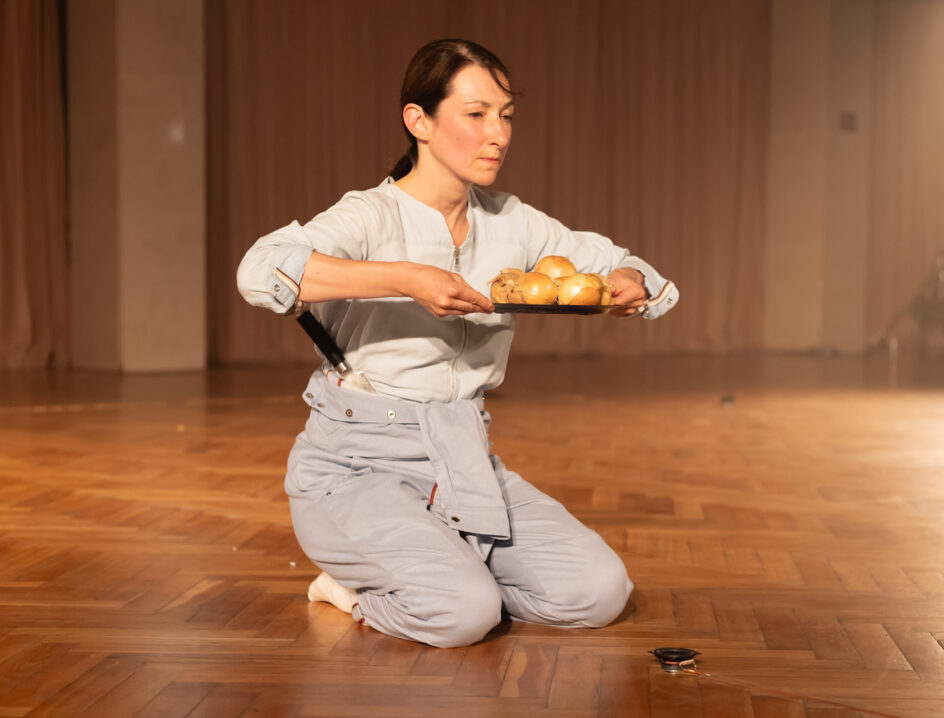
Camille Mutel: A Gesture Between Life and Death. A Relationship Appears
What separates life from death – a gesture. French choreographer Camille Mutel follows gestures in daily life, in ritual, in the countryside – tracing each movement until it becomes more than itself… We bring an interview with her from the international KoresponDance Festival 2025 in Žďár nad Sázavou where Mutel talks about her work drawing from tea ceremonies and French country tradition, and ends up with her twisting approach to collaboration with non-artists.
In Mutel’s piece Yet Each Man Kills the Thing He Loves, performed at KoresponDance, the inherited, now re-imagined, gesture of killing an animal marks the shift between being and not-being.
In Not I, the performer’s ‘I’ dissolves into the slow gestures and the objects. What arises in both performances instead is relation itself – between the one who kills and the one who is killed, between her and the spectators – just as between host and guest in the tea ceremony.
We might think of gestures as the fundamental units of action, the atoms of agency. Like light in quantum theory, wave movement remains diffuse, undecided, until observed; here, it is the attention and intention that gives it a body and shape.
Each is a gesture, a shift from one state to another – a conscious flicker of the hand, a ritual from the profane, or a picture from life. It is the moment when separation becomes relation, when movement becomes meaning.
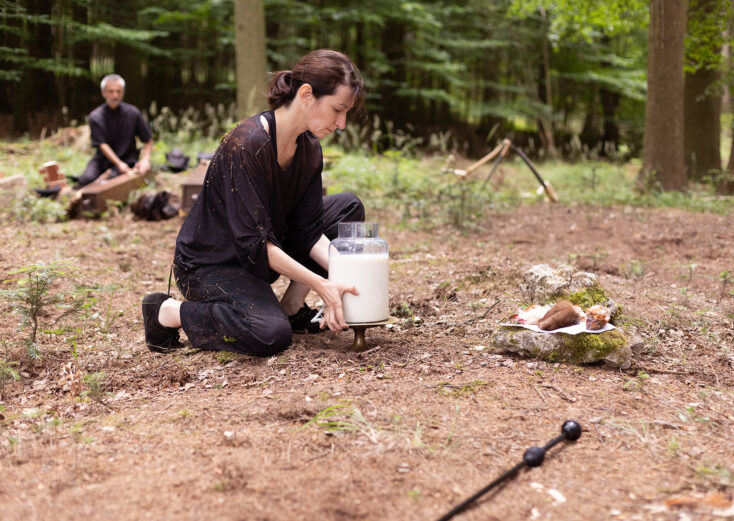
From Moves to Gestures
When I do something like this (gesturing with a pinky raised while taking a coffee), it’s a utilitarian move. When does it become a gesture in the sense you research?
We make many gestures daily without being conscious of them. Right now, for instance, we’re speaking, and my hands are moving without me controlling them consciously. In a ritual, it’s about becoming aware – with my eyes, listening – of the audience, of myself, of how and why I’m doing each gesture. That’s what makes it choreographic: something moves in space with intention. And it can also become symbolic, if I choose to use it to express something.
I try to study all these layers: how I do the gesture, what the simplest way is. I often remove small, habitual movements – like touching my hair – and keep only what’s essential. I try to write these gestures as clearly as I can, and then I ask: can it carry meaning? Can it carry poetry? Can it open consciousness?
I work a lot with slowness. When I move slowly, I see every step inside the gesture. It becomes readable – for me and for the audience – and I can engage my whole body. Even taking tea, for instance: maybe it’s not just the arm, maybe the whole body is involved. That small gesture then becomes a full-body choreographic act, with layers the audience can interpret.
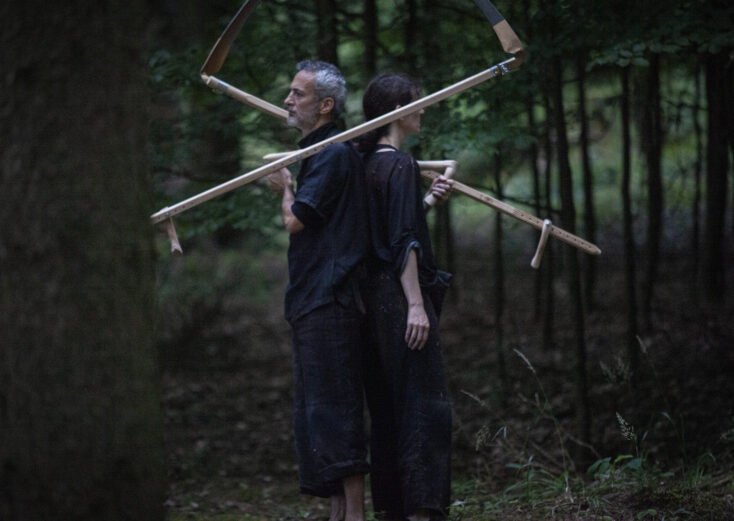
I know symbolic or conceptual gestures from many contexts. So, is this how you define a gesture? And there’s also the word geste – to act – in French. There’s agency, performativity; the act changes the world around you.
It comes from the tea ceremony. When the master prepares tea, the first layer is simply: I’m preparing this because you are my guest. It’s a way to welcome you. That’s the essence – at the end, you should feel the relationship.
The whole purpose of the tea ceremony is that I don’t know you, you don’t know me, and we will never meet again. It exists for a single encounter. We say ichigo ichie, like carpe diem – one meeting, one opportunity.
The ceremony might last twenty minutes for someone unfamiliar, or up to eight hours for someone deeply trained, because every gesture is codified. The guest has to know the codes. But the purpose is always the same: in that time, we are together, and we “sew” – like stitching – a deep relationship.
Oh, you just made another gesture…
… Afterwards, we never meet again – but the encounter must be deep and fleeting, like wind, forgotten tomorrow. All gestures exist for that reason. Behind them, the tea master imagines a theme – perhaps a storm, or exile. It can be political, poetic, different states. The more you know about the ceremony, the deeper the subject. But the master never reveals the theme.
At the end, when you drink the tea, the only words are: “How is the tea?” Your reply – raw, harsh, sweet – reflects what you felt. Those sensations connect to the theme the master intended.
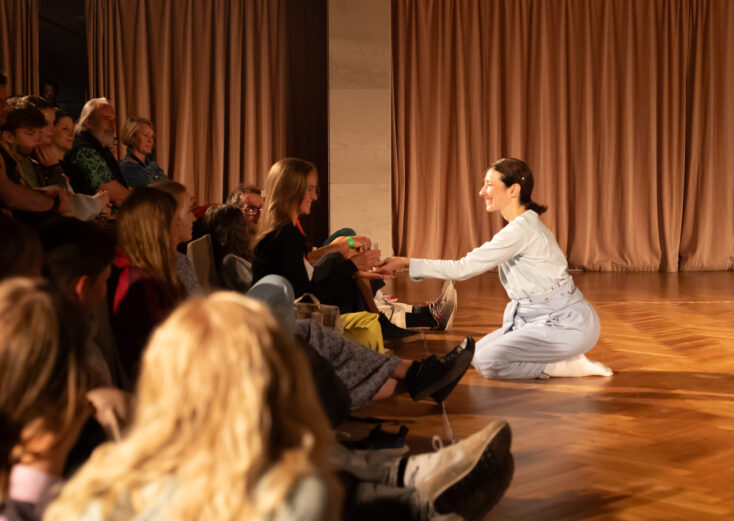
From a Ritual to a Performance
Do you have such a theme the audience isn’t aware of? A hidden, secret one – just for yourself?
I wouldn’t say a secret, because this isn’t a tea ceremony – it’s just a performance. The audience feels what they want; each person has a different experience. In this performance, I’m cutting an onion – there are tears. Then the fish: saliva comes out of my mouth, then I kill the fish, hold the knife in my mouth. It’s about life and death, blending into a kind of still life I’m building. And in painting, still life always holds that contradiction – alive yet dead. That tension is also carpe diem: I’m building something that says: live the moment, live the present.
You said “just a performance.” What do you, as an artist, add to the ritual? Maybe art is itself a ritual for the 21st century. How do you transform it into performance?
Well, I’m not a tea master – that takes decades. I studied for only six months. But I brought elements of it into my contemporary practice, dance and the presence of the body. It’s a performance because everything surrounding it is already geared towards performance; people bought tickets. The whole structure is about a festival, not a ritual. We’re not in a church, not here for healing – the audience comes for a performance.
What I build is a picture – with my body, with gestures. There’s a link to the ceremony: what interests me is how the audience enters a certain state of mind. Yesterday, for instance, we performed after a music concert in a cultural centre. We brought something completely different. Gradually, the audience learned a new way of listening – to sound, to gesture, to watching.
Disappearing Through Objects
In Not I – yesterday’s performance – your body was present, as was the fish’s, for example. But your “I” wasn’t there. Or was it?
A philosopher from the Kyoto School said that the easiest way to connect is to play chess. Gradually, you erase yourself, I erase myself, and we’re focused only on the game. Because you and I disappear – Not I, not you, but the game – then something real happens in the present between us.
In Not I, the audience comes to see a solo, but what matters is not I. It’s what I build with you: looking at you while I cut the onion, playing with your gaze, handing you the wine. The relationship through objects is what counts. The fish, the onion, the shared time – all are more important than I.
So ritual is about offering.
Yes…
So maybe the “I” is what the performer offers. Not necessarily to the audience, but the offering is somehow linked to ego.
In the tea ceremony there’s an idea some connect to the arrival of Christianity in Japan. Observing the Eucharist, they saw parallels: matcha is like the ashes of the tea master mixed with water – you drink my ashes. That’s why the tea master wears white, the colour of death in Japan. He erases his body, kills himself symbolically… and offers his ashes to the audience… Ehm… I think I lost myself a bit…
… You lost yourself like in Not I, let me keep it in the record…
The question is how to make the object, the gesture, stronger than who I am. Then, even if we don’t know each other, we can still meet. I really feel that I meet people – the woman I gave wine to, the man with the onion, the one I faced with the sheet. Just for a moment. But it exists. And that’s what I want to expand.
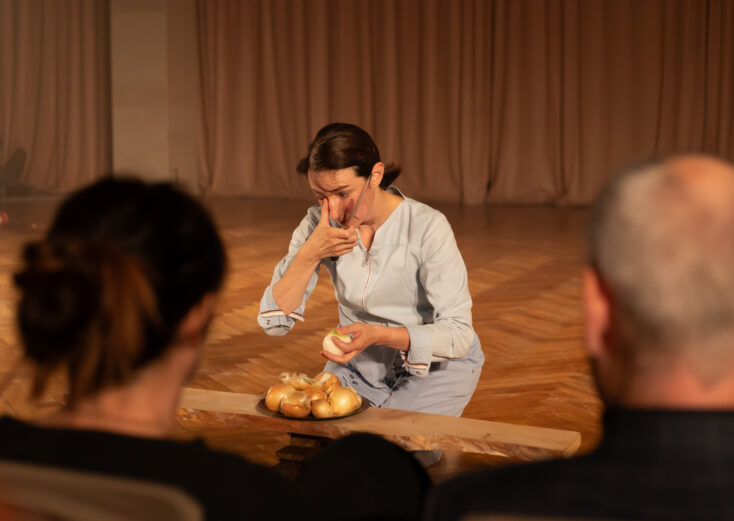
Vanishing Gestures
Let’s talk about your first in-situ performance Yet Each Man Kills the Thing He Loves. I wonder if you eat meat…
I do eat meat.
In the countryside, where you researched, killing animals is a kind of ritual. Is your performance a ritual to reconcile with what you eat? And how might urban people do the same?
It’s not only about animals. For this piece we worked with farmers, hunters, fishers – they taught us, and we followed them for a year. In France, with the rise of vegan and vegetarian movements, killing animals is widely condemned, especially among artists and younger generations. As a result, many of these gestures are vanishing, and many young people no longer take over their parents’ farms.
You mean this kind of gesture – (making the motion of cutting a throat).
Yes – how to kill a pig, a cow, a sheep. It seems simple, but carries knowledge passed down through generations on how to do it without causing suffering. Farmers witness the birth, care for the animal all its life, and finally kill it – to eat with their family. Meat isn’t daily; it’s rare and precious, because it’s a life they’ve cared for.
Often there’s a quiet ritual in it – not always, I don’t romanticise. How to hold the knife, which knife to use – knives handed down through generations. Like in the tea ceremony, tools are precious. A knife for chicken, another for sheep. In that care, there’s respect. And maybe it’s naïve, but if everyone ate only animals they had killed themselves, it would be far less problematic.
People would eat less meat…
… and with more respect. Animals give their lives for us, so it’s about making peace, giving thanks – to them and to the farmers who care for them and keep these gestures alive.
In France many young farmers no longer know how. They say, “I just want to make milk and cheese.” But for that you need calves, and if you have calves, you must kill some, otherwise in two years you’ll have a hundred. So even if you don’t eat meat, by drinking milk or eating cheese, there is still an animal’s death behind it.
Even walking, driving, building – all our actions affect animals. We survive because we kill them. So the question is: how do we give thanks?
So everyone could have a personal ritual before eating meat…
Yes – to be conscious. As in the tea ceremony, as in Not I. To be aware of what you’re watching, eating, drinking. Awareness.
How Spectators Teach Artists
This festival is site-specific. If you came here to Žďár for a residency, how would you begin your research? Stones, trees, gestures – what would be the first step?
I don’t know if this is the right answer, but now politics push us to interact with non-artists, to work with people. I think it’s a good starting point. I always felt we were trained to stay slightly apart – living daily life, then retreating into the studio. Now we’re asked to go into towns, meet people, work with them. Maybe it won’t bring bigger audiences, but it builds real relationships. It says art is part of daily life. A farmer killing a pig is already making art – because when I watch and treat that gesture as important, something shifts. He may hold or move differently. As a dancer, that’s fascinating.
The people we observe become actors, dancers. Their body, awareness of space, use of objects – all shift, simply because I say: I’m watching how you use objects. And in that moment…
… The move becomes a gesture?
Of course, it’s great if they later come to see the show, but the exchange has already happened. For us as artists it’s vital to realise they are our teachers. I bring my dance background, they bring lived experience – and they have so much to teach me.
Compagnie Li(luo): Pourtant chacun tue ce qu’il aime (Yet Each Man Kills the Thing He Loves)
Movement that speaks without words. You will experience a performance that is simultaneously a ritual, a memory, and a call to honor all things living. Discover the depth and voice of this quiet performance!
Yet Each Man Kills the Thing He Loves is part of a tetralogy exploring gesture as a strength that binds us together. This new installment in the series continues the search for the rhythm of the seasons and creates a ritual of hunting as an homage to animals and all things living. It transforms rural customs and habits – especially those related to killing for a living – into choreography. In this way, the performance pays tribute to all animals affected by these customs, viewing them as part of a cycle from birth to death that nevertheless deeply values life.
Concept and Dramaturgy: Camille Mutel
Performers: Kerem Gelebek, Camille Mutel
Compagnie Li(luo): Not I
Camille Mutel invites you to reflect on everyday life and our relationship to food, which she sees as a ceremony. Finding inspiration in Japanese traditions, in her work she mixes an aesthetic and philosophical experience with an unforgettable artistic statement.
The solo performance Not I is a quiet, slow piece that guides us back to ordinary gestures – pouring a glass of wine, peeling an onion, the movement of fish. The body moves with precision and gentleness in a space where every detail has meaning. Mutel draws on Japanese tea ceremonies to create a scene that is not about her but about us all, about being with others while not hurrying, without pressures, and in true closeness.
Concept, Dramaturgy, and Performance: Camille Mutel
Website: www.compagnie-li-luo.fr
Performance: 23 July 2025 at the KoresponDance Festival in Žďár nad Sázavou, Dům kultury
